Module 3 - Benjamin-Mills
Module 3 - Benjamin-Mills
Module 3 - Benjamin-Mills
You also want an ePaper? Increase the reach of your titles
YUMPU automatically turns print PDFs into web optimized ePapers that Google loves.
EP7<br />
Check your notes on<br />
Engineering Proteins<br />
This activity helps you get your notes in order at the<br />
end of this unit.<br />
Use this list as the basis of a summary of the unit by<br />
collecting together the related points and arranging them in<br />
groups. Check that your notes cover the points and are<br />
organised in appropriate ways. Remember that you will be<br />
coming back to some of the ideas in later units.<br />
Most of the points are covered in the Chemical Ideas,<br />
with supporting information in the Storyline or Activities.<br />
However, if the main source of information is the Storyline<br />
or an Activity, this is indicated.<br />
●<br />
●<br />
●<br />
●<br />
●<br />
●<br />
●<br />
●<br />
●<br />
●<br />
●<br />
●<br />
Proteins are condensation polymers formed from amino<br />
acid monomers.<br />
The general structure of amino acids.<br />
The acid–base properties of amino acids and the<br />
formation of zwitterions.<br />
The formation and hydrolysis of the peptide link between<br />
amino acid residues in proteins (Storyline EP2; Activity<br />
EP2.2).<br />
The use of paper chromatography to identify amino acids<br />
(Activity EP2.2).<br />
The importance of amino acid sequence in determining<br />
the properties of proteins, and the diversity of proteins in<br />
living things (Storyline EP2).<br />
Stereo-isomers: cis-trans and optical isomers<br />
(enantiomers).<br />
The use of the term chiral as applied to a molecule.<br />
How nuclear magnetic resonance (n.m.r.) spectroscopy<br />
can be used for the elucidation of molecular structure.<br />
The interpretation of n.m.r. spectra for simple compounds<br />
given relevant information (Activity EP2.3).<br />
The expression for the equilibrium constant, K c<br />
, for a given<br />
reaction.<br />
The way in which changes of temperature and pressure<br />
affect the magnitude of the equilibrium constant.<br />
●<br />
●<br />
●<br />
●<br />
●<br />
●<br />
●<br />
●<br />
●<br />
●<br />
●<br />
●<br />
●<br />
●<br />
●<br />
The use of values of K c<br />
, together with given data on<br />
equilibrium concentrations, to calculate the composition<br />
of equilibrium mixtures.<br />
The primary, secondary and tertiary structures of proteins<br />
(Storyline EP4).<br />
The role of hydrogen bonds and other intermolecular<br />
forces in determining the structure and properties of<br />
proteins (Storyline EP4).<br />
The double helix structure of DNA in terms of a<br />
sugar–phosphate backbone and attached bases (Storyline<br />
EP2).<br />
The significance of hydrogen bonding in the pairing of<br />
bases in DNA, and the replication of genetic information<br />
(Storyline EP2; Activities EP2.7 and EP2.8).<br />
How DNA encodes for the amino acid sequence in a<br />
protein.<br />
The use of empirical rate equations of the form:<br />
rate = k[A] m [B] n where m and n are integers.<br />
The meaning of the terms: rate of reaction, rate constant,<br />
order of reaction (both overall and with respect to a given<br />
reagent).<br />
Experimental methods for measuring the rate of reactions.<br />
How to use experimental data to find the order of a<br />
reaction (zero, first or second order).<br />
How to use given data to calculate half-lives for a reaction.<br />
The industrial importance of enzymes (Storyline EP6).<br />
The characteristics of enzyme catalysis, including:<br />
specificity, temperature and pH sensitivity, and inhibition<br />
(Storyline EP6).<br />
The specificity of enzymes in terms of a simple ‘lock and<br />
key’ model of enzyme action.<br />
The technique of ‘genetic engineering’ and its applications<br />
(Storyline EP3 and EP5).<br />
EP<br />
© Harcourt Education Ltd 2004 Salters Advanced Chemistry<br />
These pages have been downloaded from www.heinemann.co.uk/science<br />
2


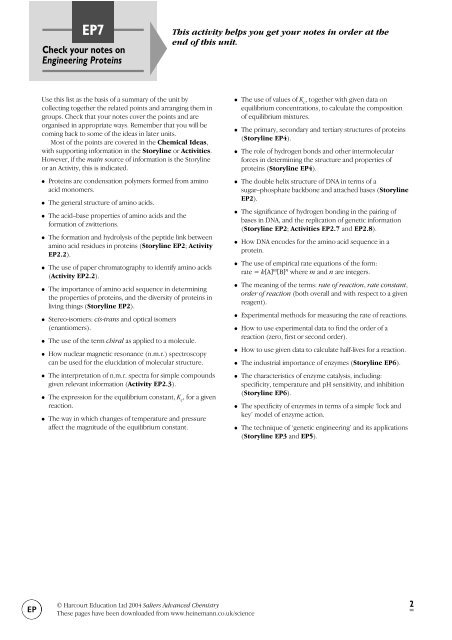
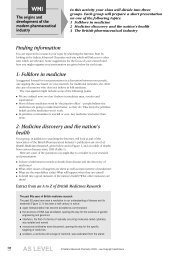
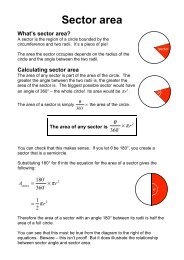
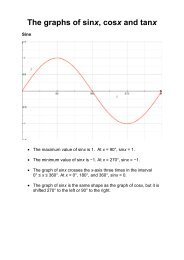


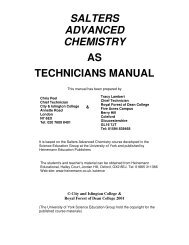



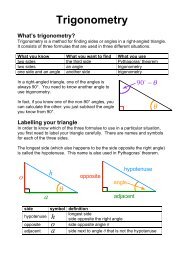
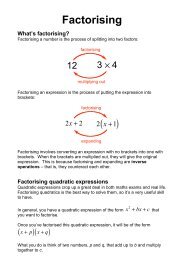
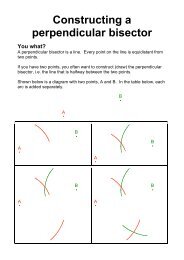


![ISI Web of Knowledge [v.4.10] - All Databases Results - Benjamin-Mills](https://img.yumpu.com/39253071/1/184x260/isi-web-of-knowledge-v410-all-databases-results-benjamin-mills.jpg?quality=85)